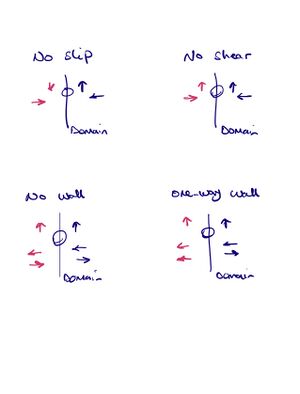Windtunnel/Boundary Conditions: Difference between revisions
Jump to navigation
Jump to search
(HG_3D) |
|||
| Line 56: | Line 56: | ||
Setting the vector | Setting the vector | ||
= Analytical Solutions = | |||
== empty 2D channel == | |||
== empty circular tube == | |||
$$ | |||
v(r) = \frac{\text dp}{\text dx}\frac{R^2-r^2}{4\mu} | |||
$$ | |||
with | |||
Revision as of 10:51, 2 October 2024
New Keywords
in pluto.ini
ObjectType_int: 0=nothing, 1=cylinder/sphere, 2=square/cube of sizeObjectDiameter_cmWindPressure_Pa,WindPressure_mbar(mutually exclusive): pressure at entry (left)PressureGradient_mbar_per_cmpositive (even though pressure drops from left to right)- Wind velocity is ramped up to
WindVelocity_m_per_sover timeInjectionTime_s WindTemperature_CKinematicViscosity_m2_per_s,DynamicViscosity_Pa_s,Wall_BoundaryConditionfor tangential walls, value from {0,1,2,3}
(ignored if given values <0)
in init.c
- macro
SOLIDto enable an object - array
solidcontaining value 1 or 0 for object matter being present/absent
Walls
tangential
| Boundary condition for the wall | ||
|---|---|---|
| vx1 | vx2 | |
| no-shear | zero-gradient | reflective |
| no-slip | reflective | reflective |
| no-wall | zero-gradient | zero-gradient |
| one-way wall | zero-gradient | zero-gradient & no-inflow |
entry/exit
prescribed velocity at entry (left)
prescribe pressure drop (left to right)
- current simulation result:
Object
Open Questions
Reflective cells
Setting the vector
Analytical Solutions
empty 2D channel
empty circular tube
with
